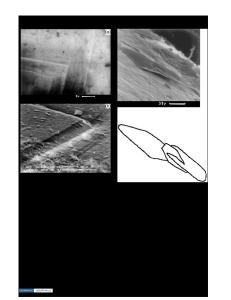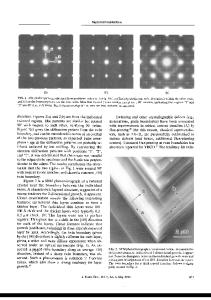Effect of filament architecture on magnetic flux distributions in multifilamentary (Bi, Pb) 2 Sr 2 Ca 2 Cu 3 O x /Ag com
- PDF / 482,189 Bytes
- 11 Pages / 612 x 792 pts (letter) Page_size
- 37 Downloads / 364 Views
MATERIALS RESEARCH
Welcome
Comments
Help
Effect of filament architecture on magnetic flux distributions in multifilamentary (Bi, Pb)2 Sr2 Ca2 Cu3 Oxy Ag composites Debra L. Kaiser and Marina Turchinskaya Ceramics Division, National Institute of Standards and Technology, Gaithersburg, Maryland 20899
Gilbert N. Riley, Jr. and Craig Christopherson American Superconductor Corporation, Two Technology Drive, Westborough, Massachusetts 01581 (Received 15 April 1997; accepted 14 May 1997)
Multifilamentary (Bi, Pb)2 Sr2 Ca2 Cu3 OxyAg composites have been studied by a nondestructive magneto-optical imaging technique in order to determine the effect of filament architecture on the local magnetic flux distribution. The images reveal the homogeneity of the flux distribution in the upper layer filaments under magnetizing and demagnetizing conditions, and the alignment and morphology of these filaments in tapes with nine different composite structures. Certain types of filament arrangements led to homogeneous flux distributions, while other types caused localized inhomogeneities in the flux distribution. Nonuniform filament thickness also resulted in a highly inhomogeneous flux distribution. These results are useful in selecting optimal composite structures for power applications.
I. INTRODUCTION
Presently, the most promising high temperature superconducting materials for power applications are composite tapes composed of superconducting (Bi, Pb)2 Sr2 Ca2 Cu3 Ox (BSCCO-2223) filaments embedded in a silver matrix. Considerable effort is directed toward increasing the transport critical current density, Jct , of these materials above the level of 104 Aycm2 reported for long (.1 km) lengths of tape at 77 K.1 Since Jct is influenced primarily by microstructural features in the tapes that serve either as weak links or flux pinning centers,2 measurements of the local magnetic flux distribution can provide considerable insight into the current limiting or strengthening mechanisms. Both magnetooptical (MO)3–9 and micro-Hall probe10 techniques have been used to determine local flux distributions in BSCCO-2223yAg or (Bi, Pb)2 Sr2 Ca1 Cu2 Ox (BSCCO2212)yAg composites under applied magnetic fields. In some of these studies,3–6 current paths and critical current densities were calculated from the flux distributions and related to the microstructure of the tapes. Magneto-optical studies of BSCCOyAg composites have been commonly performed on polished sections of tape in order to obtain good physical contact between the magneto-optically active indicator film and the BSCCO filaments.3–8 In a recent Communication,9 we showed that the filaments can be imaged directly through the outer silver sheath of an unpolished composite tape, thereby demonstrating the potential of MO imaging as a nondestructive diagnostic tool for these materials. The MO images from the two tapes in our earlier study revealed the morphology and alignment of the uppermost 3074
http://journals.cambridge.org
J. Mater. Res., Vol. 12, No. 11, Nov 1997
Downloaded: 20 Mar
Data Loading...











